
A | B | C | D | E | F | G | H | CH | I | J | K | L | M | N | O | P | Q | R | S | T | U | V | W | X | Y | Z | 0 | 1 | 2 | 3 | 4 | 5 | 6 | 7 | 8 | 9
| Pictures at an Exhibition | |
|---|---|
| Suite by Modest Mussorgsky | |
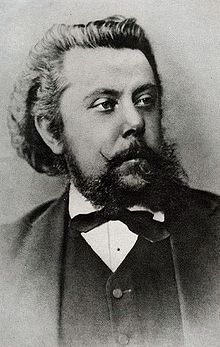 Mussorgsky in 1874 | |
| Native name | Kartinki s vïstavski |
| Based on | An exhibition of Viktor Hartmann's pictures |
| Composed | 2–22 June 1874 |
| Dedication | Vladimir Stasov |
| Published | 1886 |
| Duration | About 35 minutes |
| Movements | Ten, plus a recurring, varied Promenade theme |
| Scoring | Solo piano |
Pictures at an Exhibition[a] is a piano suite in ten movements, plus a recurring and varied Promenade theme, written in 1874 by Russian composer Modest Mussorgsky. It is a musical depiction of a tour of an exhibition of works by architect and painter Viktor Hartmann put on at the Imperial Academy of Arts in Saint Petersburg, following his sudden death in the previous year. Each movement of the suite is based on an individual work, some of which are lost.
The composition has become a showpiece for virtuoso pianists, and became widely known from orchestrations and arrangements produced by other composers and contemporary musicians, with Maurice Ravel's 1922 adaptation for orchestra being the most recorded and performed. The suite, particularly the final movement, "The Bogatyr Gates", is widely considered one of Mussorgsky's greatest works.
Composition history

The composition is based on pictures by the artist, architect, and designer Viktor Hartmann. It was probably in 1868 that Mussorgsky first met Hartmann, not long after the latter's return to Russia from abroad. Both men were devoted to the cause of an intrinsically Russian art and quickly became friends. They likely met in the home of the influential critic Vladimir Stasov, who followed both of their careers with interest. According to Stasov's testimony, in 1868, Hartmann gave Mussorgsky two of the pictures that later formed the basis of Pictures at an Exhibition.[1] In 1870, Mussorgsky dedicated the second song ("In the Corner") of the cycle The Nursery to Hartmann. Stasov remarked that Hartmann loved Mussorgsky's compositions, and particularly liked the "Scene by the Fountain" in his opera Boris Godunov. Mussorgsky had abandoned the scene in his original 1869 version, but at the requests of Stasov and Hartmann, he reworked it for Act 3 in his revision of 1872.[2]
The years 1873–74 are associated with the staging of Boris Godunov, the zenith of Mussorgsky's career as a composer—at least from the standpoint of public acclaim. Mussorgsky's distant relative, friend, and roommate during this period, Arseniy Golenishchev-Kutuzov, describing the January 1874 premiere of the opera, remarked: "During the winter, there were, I think, nine performances, and each time the theatre was sold out, each time the public tumultuously called for Mussorgsky."[3] The composer's victory, however, was overshadowed by the negative press he received from critics. Other circumstances conspired to dampen Mussorgsky's spirits. The disintegration of The Mighty Handful and their failure to understand his artistic goals contributed to the isolation he experienced as an outsider in Saint Petersburg's musical establishment. Golenishchev-Kutuzov wrote: " banner was held by Mussorgsky alone; all the other members had left it and pursued his own path ..."[4]
Hartmann's sudden death on 4 August 1873 from an aneurysm shook Mussorgsky along with others in Russia's art world. The loss of the artist, aged only 39, plunged the composer into deep despair. Stasov helped to organize a memorial exhibition of over 400 Hartmann works in the Imperial Academy of Arts in Saint Petersburg in February and March 1874. Mussorgsky lent to the exhibition the two pictures Hartmann had given him, and viewed the show in person. Later in June, two-thirds of the way through composing his song cycle Sunless, Mussorgsky was inspired to compose Pictures at an Exhibition, quickly completing the score in three weeks (2–22 June 1874).[5] In a letter to Stasov (see photo), probably written on 12 June 1874, he describes his progress:

My dear généralissime, Hartmann is boiling as Boris boiled—sounds and ideas hung in the air, I am gulping and overeating, and can barely manage to scribble them on paper. I am writing the 4th No.—the transitions are good (on the 'promenade'). I want to work more quickly and steadily. My physiognomy can be seen in the interludes. So far I think it's well turned ...[6]
The music depicts his tour of the exhibition, with each of the ten numbers of the suite serving as a musical illustration of an individual work by Hartmann.[7]
Five days after finishing the composition, he wrote on the title page of the manuscript a tribute to Vladimir Stasov, to whom the work is dedicated. One month later, he added an indication that he intended to have it published.[8]
Golenishchev-Kutuzov gives the following (perhaps biased)[9] account of the work's reception among Mussorgsky's friends and colleagues and an explanation for his failure to follow through on his plans to publish it:
Soon, with the composition of the musical illustrations for Pictures from an Exhibition by the architect Hartmann, he reached the acme of that musical radicalism, to whose 'new shores' and to whose 'unfathomed depths' the admirers of his 'Peepshows' and 'Savishnas' had pushed him so diligently. In music for these illustrations, as Mussorgsky called them, he represented , children, Baba Yaga in her wooden house on chicken legs, catacombs, gates, and even rattling carts. All this was not done jokingly, but 'seriously'.
There was no end to the enthusiasm shown by his devotees; but many of Mussorgsky's friends, on the other hand, and especially the comrade composers, were seriously puzzled and, listening to the 'novelty,' shook their heads in bewilderment. Naturally, Mussorgsky noticed their bewilderment and seemed to feel that he 'had gone too far.' He set the illustrations aside without even trying to publish them. Mussorgsky devoted himself exclusively to Khovanshchina.[10]
In August, Mussorgsky completed the last two songs of Sunless and then resumed work on Khovanshchina, composing the prelude to Act 1 ("Dawn on the Moscow River") in September.
Publication history

As with most of Mussorgsky's works, Pictures at an Exhibition has a complicated publication history. Although composed very rapidly, during June 1874, the work did not appear in print until 1886, five years after the composer's death, when an edition by the composer's friend and colleague Nikolai Rimsky-Korsakov was published. This edition, however, was not a completely accurate representation of Mussorgsky's score but presented a revised text that contained a number of errors and misreadings.
Only in 1931, marking the 50th anniversary of the composer's death, was Pictures at an Exhibition published in a scholarly edition in agreement with his manuscript, to be included in Volume 8 of Pavel Lamm's M. P. Mussorgsky: Complete Collected Works (1939).
In 1940, the Italian composer Luigi Dallapiccola published an important critical edition of Mussorgsky's work with extensive commentary.
Mussorgsky's hand-written manuscript was published in facsimile in 1975.
Year Editor Publisher Notes 1886 Nikolay Rimsky-Korsakov V. Bessel and Co., Saint Petersburg Revised edition 1931 Pavel Lamm Muzgiz, Moscow Restoration of the composer's score 1975 —Muzïka, Moscow Facsimile of the composer's manuscript
Hartmann's pictures

Mussorgsky based his musical material on drawings and watercolours by Hartmann produced mostly during the artist's travels abroad. Locales include Italy, France, Poland, Russia, and Ukraine. Today most of the pictures from the Hartmann exhibition are lost, making it impossible to be sure in many cases which Hartmann works Mussorgsky had in mind.
Arts critic Alfred Frankenstein gave an account of Hartmann, with reproductions of his pictures, in the article "Victor Hartmann and Modeste Mussorgsky" in The Musical Quarterly (July 1939).[11] Frankenstein claimed to have identified seven pictures by catalogue number, corresponding to:
- "Tuileries" (now lost)
- "Ballet of the Unhatched Chicks"
- "Samuel Goldenberg and Schmuÿle" (Frankenstein suggested two separate portraits, still extant, as the basis for "Two Jews: Rich and Poor")
- "Catacombs"
- "The Hut on Hen's Legs"
- "The Bogatyr Gates"
The surviving works that can be shown with certainty to have been used by Mussorgsky in assembling his suite, along with their titles, are as follows:[1]
Movement Title Title (English) Picture 5. Ballet of the Unhatched Chicks Эскизы театральных костюмов к балету "Трильби" Sketches of theatre costumes for the ballet Trilby 
6. "Samuel" Goldenberg and "Schmuÿle" Еврей в меховой шапке. Сандомир Jew in a fur cap. Sandomierz 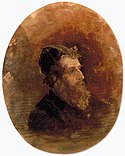
Сандомирский Sandomierz 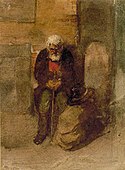
8. Catacombs (Roman Tomb) Парижские катакомбы (с фигурами В. А. Гартмана, В. А. Кенеля и проводника, держащего фонарь) Paris Catacombs (with the figures of V. A. Hartmann, V. A. Kenel, and a guide holding a lantern) 
9. The Hut on Hen's Legs ( of Baba Yaga) Избушка Бабы-Яги на курьих ножках. Часы в русском стиле The hut of Baba-Yaga on hen's legs. Clock in the Russian style 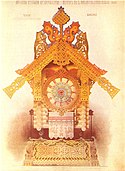
10. The Bogatyr Gates (In the Capital in Kiev) Проект городских ворот в Киеве. Главный фасад Project for city gates in Kiev. Main façade 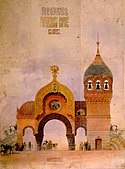
Note: Mussorgsky owned the two pictures that together inspired No. 6, the so-called "Two Jews". The title of No. 6b, as provided by the Soviet editors of his letters, is Сандомирский (Sandomirskiy or Sandomierz ). The bracketed word yevrey (lit. "Hebrew") is the sanitized form of the actual word in the title, very likely the derogatory epithet жид (zhid or yid).[12]
Movements
Vladimir Stasov's program, identified below,[13] and the six known extant pictures suggest the ten pieces that make up the suite correspond to eleven pictures by Hartmann, with "Samuel Goldenberg und Schmuÿle" accounting for two. The five Promenades are not numbered with the ten pictures and consist in the composer's manuscript of two titled movements and three untitled interludes appended to the first, second, and fourth pictures.[14]
Mussorgsky links the suite's movements in a way that depicts the viewer's own progress through the exhibition. Two Promenade movements stand as portals to the suite's main sections. Their regular pace and irregular meter depicts the act of walking. Three untitled interludes present shorter statements of this theme, varying the mood, colour, and key in each to suggest reflection on a work just seen or anticipation of a new work glimpsed. A turn is taken in the work at the "Catacombae" when the Promenade theme stops functioning as merely a linking device and becomes, in "Cum mortuis", an integral element of the movement itself. The theme reaches its apotheosis in the suite's finale, "The Bogatyr Gates".
The first two movements of the suite—one grand, one grotesque—find mirrored counterparts, and apotheoses, at the end. The suite traces a journey that begins at an art exhibition, but the line between observer and observed vanishes at the Catacombs when the journey takes on a different character.
The table below shows the order of movements.
No. Title in score English translation Key Meter Tempo Promenade B♭ major 5
4, 6
4Allegro giusto, nel modo russico; senza allegrezza, ma poco sostenuto 1 Gnomus (Latin) The Gnome E♭ minor 3
4Vivo and Meno mosso, pesante Promenade A♭ major 5
4, 6
4Moderato commodo assai e con delicatezza 2 Il vecchio castello (Italian) The Old Castle G♯ minor 6
8Andante molto cantabile e con dolore Promenade B major 5
4, 6
4Moderato non tanto, pesamente 3 Tuileries (Dispute d'enfants après jeux) (French) Tuileries (Children's Quarrel after Games) B major 
Allegretto non troppo, capriccioso 4 Bydło (Polish) Cattle G♯ minor 2
4Sempre moderato, pesante Promenade D minor 5
4, 6
4, 7
4Tranquillo 5 Балет невылупившихся птенцов (Russian)
Balet nevylupivshikhsya ptentsov (trans.)Ballet of Unhatched Chicks F major 2
4Scherzino 6 "Samuel" Goldenberg und "Schmuÿle" (Yiddish) "Samuel" Goldenberg and "Schmuÿle" B♭ minor 
Andante. Grave energico and Andantino Promenade B♭ major 5
4, 6
4, 7
4Allegro giusto, nel modo russico; poco sostenuto 7 Limoges. Le marché (La grande nouvelle) (French) Limoges. The Market (The Great News) E♭ major 
Allegretto vivo, sempre scherzando 8 Catacombae (Sepulcrum romanum) (Latin) Catacombs (Roman Tomb) B minor 3
4Largo Cum mortuis in lingua mortua (Latin) With the Dead in a Dead Language B minor 6
4Andante non troppo con lamento 9 Избушка на курьих ножках (Баба-Яга) (Russian)
Izbushka na kuryikh nozhkakh (Baba-Yaga) (trans.)The Hut on Hen's Legs (Baba Yaga) C minor 2
4Allegro con brio, feroce and Andante mosso 10 Богатырские ворота (В стольном городе во Киеве) (Russian)
Bogatyrskiye vorota (V stolnom gorode vo Kiyeve) (trans.)The Bogatyr Gates (In the Capital in Kiev)
(Often translated as "The Great Gate of Kiev" or "The Heroes' Gate at Kiev")E♭ major 
Allegro alla breve. Maestoso, con grandezza
Promenade
Vladimir Stasov's comment: In this piece Mussorgsky depicts himself "roving through the exhibition, now leisurely, now briskly in order to come close to a picture that had attracted his attention, and at times sadly, thinking of his departed friend."
The piece has simple, strong rhythms in asymmetrical meter. The promenade theme is shown below:

1. The Gnome
Stasov's comment: "A sketch depicting a little gnome, clumsily running with crooked legs."
Hartmann's sketch, now lost, is thought to represent a design for a nutcracker displaying large teeth. The lurching music, in contrasting tempos with frequent stops and starts, suggests the movements of the gnome.

Promenade (2nd)
A placid statement of the promenade melody depicts the viewer walking from one display to the next.

2. The Old Castle
Stasov's comment: "A medieval castle before which a troubadour sings a song."
This movement is thought to be based on a watercolor depiction of an Italian castle and is portrayed in Ravel's orchestration by a bassoon and alto saxophone duet. Hartmann often placed appropriate human figures in his architectural renderings to suggest scale.[15]

Promenade (3rd)edit
Another brief statement of the promenade melody (8 measures) gives it more extroversion and weight than before.

3. Tuileries (Children's Quarrel after Games)edit
Stasov's comment: "An avenue in the garden of the Tuileries, with a swarm of children and nurses."
Hartmann's picture of the Jardin des Tuileries near the Louvre in Paris (France) is now lost. Figures of children quarrelling and playing in the garden were likely added by the artist for scale (see note on No. 2 above).
The movement is cast in through-composed ternary form (ABA).

4. Cattleedit
Stasov's comment: "A Polish cart on enormous wheels, drawn by oxen."
The movement is cast in through-composed ternary form (ABA) with coda. Mussorgsky's original piano version of this movement begins fortissimo (ff), suggesting that the lumbering oxcart's journey begins in the listener's foreground. After reaching a climax (con tutta forza), the dynamic marking is abruptly piano (bar 47), followed by a diminuendo to a final pianississimo (ppp), suggesting the oxcart receding into the distance. Rimsky-Korsakov's edition, and arrangements based on it such as Ravel's, begin quietly, build gradually (crescendo) to fortissimo and then undergo a diminuendo, suggesting the oxcart approaching, passing the listener, and then receding.

Promenade (4th)edit
A reflective 10-measure presentation of the promenade theme.

5. Ballet of Unhatched Chicksedit
Stasov's comment: "Hartmann's design for the décor of a picturesque scene in the ballet Trilby."
Gerald Abraham provides the following details: "Trilby or The Demon of the Heath, a ballet with choreography by Petipa, music by Julius Gerber, and décor by Hartmann, based on Charles Nodier's Trilby, or The Elf of Argyle, was produced at the Bolshoi Theatre, Saint Petersburg, in 1871. The fledglings were canary chicks."[16]
The movement is cast in ternary form (ABA) with a literal repeat and terse extension (coda).

6. "Samuel" Goldenberg and "Schmuÿle"edit
Stasov's comment: "Two Jews: rich and poor" (Russian: Два еврея: богатый и бедный)
Stasov's explanatory title elucidates the personal names used in Mussorgsky's original manuscript. Published versions display various combinations, such as "Two Polish Jews, Rich and Poor (Samuel Goldenberg and Schmuyle)". The movement is thought to be based on two separate extant portraits.
The use of augmented second intervals approximates Jewish modes such as the Phrygian dominant scale. The movement is in ternary form A – B – A+B:
- Andante, grave energico (Theme 1 "Samuel Goldenberg")
- Andantino (Theme 2 "Schmuÿle")
- Andante, grave energico (Themes 1 and 2 in counterpoint)
- Coda

Promenade (5th)edit
A nearly bar-for-bar restatement of the opening promenade. Differences are slight: condensed second half, block chords voiced more fully. Structurally, the movement acts as a reprise, giving listeners another hearing of the opening material before these are developed in the second half of the suite.
Many arrangements, including Ravel's orchestral version, omit this movement.

7. Limoges. The Market (The Great News)edit
Stasov's comment: "French women quarrelling violently in the market."
Limoges is a city in central France. Mussorgsky originally provided two paragraphs in French that described a marketplace discussion (the 'great news'), but subsequently crossed them out in the manuscript.
The movement is a scherzo in through-composed ternary form (ABA). A scurrying coda leads without a break into the next movement.

8. Catacombs (Roman Tomb) – With the Dead in a Dead Languageedit

Stasov's comment: "Hartmann represented himself examining the Paris catacombs by the light of a lantern."
The movement is in two distinct parts. Its two sections consist of a nearly static Largo consisting of a sequence of block chords with elegiac lines adding a touch of melancholy and a more flowing, gloomy Andante that introduces the Promenade theme into the scene.
The first section's alternating loud and soft chords evoke the grandeur, stillness, and echo of the catacombs. The second section suggests a merging of observer and scene as the observer descends into the catacombs. Mussorgsky's manuscript of "Catacombs" (shown right) displays two pencilled notes, in Russian: "NB – Latin text: With the dead in a dead language" and, along the right margin, "Well may it be in Latin! The creative spirit of the dead Hartmann leads me towards the skulls, invokes them; the skulls begin to glow softly."

9. The Hut on Hen's Legs (Baba Yaga)edit
Stasov's comment: "Hartmann's drawing depicted a clock in the form of Baba Yaga's hut on hen's legs. Mussorgsky added the witch's flight in a mortar."
A scherzo marked Feroce with a slower middle section. Motives in this movement evoke the bells of a large clock and the whirlwind sounds of a chase. Structurally, the movement mirrors the grotesque qualities of "Gnomus" on a grand scale.
The movement is cast in ternary form (ABA):
- Allegro con brio, feroce
- Andante mosso
- Allegro molto (a nearly literal repeat)
- Coda
The coda leads without a break into the final movement of the suite.

10. The Bogatyr Gates (In the Capital in Kiev)edit
Stasov's comment: "Hartmann's sketch was his design for city gates at Kiev in the ancient Russian massive style with a cupola shaped like a slavonic helmet."
Bogatyrs are heroes that appear in Russian epics called bylinas. Hartmann designed a monumental gate for Tsar Alexander II to commemorate the monarch's narrow escape from an assassination attempt on April 4, 1866. Hartmann regarded his design as the best work he had done. His design won the national competition but plans to build the structure were later cancelled.
The movement's grand main theme exalts the opening Promenade much as "Baba Yaga" amplified "Gnomus"; also like that movement, it evens out the meter of its earlier counterpart. The solemn secondary theme is based on a baptismal hymn from the repertory of Russian Orthodox chant.
The movement is cast as a broad rondo in two main sections: ABAB–CADA. The first half of the movement sets up the expectation of an ABABA pattern. The interruption of this pattern with new music just before its expected conclusion gives the rest of the movement the feeling of a vast extension. This extended leave-taking acts as a coda for the suite as a whole.
- A: Main Theme (forte, then fortissimo); maestoso
- B: Hymn Theme (piano) (A♭ minor); senza espressione (without expression)
- A: Main Theme (forte); descending and ascending scale figures suggest carillons.
- B: Hymn Theme (piano) (E♭ minor); senza espressione
- C: Interlude/Transition (mezzo forte with crescendo to forte); promenade theme recalled. Suggestions of clockwork, bells, ascent.
- A: Main Theme (fortissimo); Meno mosso, sempre maestoso. Triplet figuration.
- D: Interlude/Transition (mezzo forte with crescendo). Triplets. Zdroj:https://en.wikipedia.org?pojem=Pictures_at_an_Exhibition
Text je dostupný za podmienok Creative Commons Attribution/Share-Alike License 3.0 Unported; prípadne za ďalších podmienok. Podrobnejšie informácie nájdete na stránke Podmienky použitia.
Antropológia
Aplikované vedy
Bibliometria
Dejiny vedy
Encyklopédie
Filozofia vedy
Forenzné vedy
Humanitné vedy
Knižničná veda
Kryogenika
Kryptológia
Kulturológia
Literárna veda
Medzidisciplinárne oblasti
Metódy kvantitatívnej analýzy
Metavedy
Metodika
Text je dostupný za podmienok Creative
Commons Attribution/Share-Alike License 3.0 Unported; prípadne za ďalších
podmienok.
Podrobnejšie informácie nájdete na stránke Podmienky
použitia.
www.astronomia.sk | www.biologia.sk | www.botanika.sk | www.dejiny.sk | www.economy.sk | www.elektrotechnika.sk | www.estetika.sk | www.farmakologia.sk | www.filozofia.sk | Fyzika | www.futurologia.sk | www.genetika.sk | www.chemia.sk | www.lingvistika.sk | www.politologia.sk | www.psychologia.sk | www.sexuologia.sk | www.sociologia.sk | www.veda.sk I www.zoologia.sk







